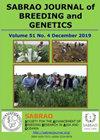生物强化水稻品系植酸含量及其与微量营养素含量和稻米产量的关系
IF 1.7
Q3 PLANT SCIENCES
引用次数: 0
摘要
铁和锌是人体生长、发育和免疫系统维持所必需的微量营养素。铁(Fe)和锌(Zn)是精神运动发育、持续的身体活动和工作能力、抗感染和各种代谢功能所必需的。目前,人们首选的是富含铁和锌的大米,同时也是抗营养化合物(即植酸)含量较低的大米。本研究旨在鉴定几种生物强化水稻品系的植酸含量,并确定植酸与铁、锌含量和产量性状的相关性。该研究于2022年1月至9月的旱季(DS)进行,在印度尼西亚西爪哇省苏邦的ICRIST Sukamandi实验站(海拔40米)进行了冲积土类型的研究。对10个基因型水稻(Oryza sativa L.)进行试验,其中包括6个BC4F3高锌生物强化水稻品系和4个对照品种(Inpari IR Nutri Zinc、Inpari 23、Ciherang和Sintanur),试验采用随机完全区组设计,3个重复。相关分析确定了低植酸高锌铁水稻的选育策略。结果表明,植酸与锌含量、千粒重和单株产量无显著相关。植酸与铁含量呈极显著正相关。与所有对照品种相比,水稻WR10锌含量最高(33.80 mg kg-1),植酸锌比(PA: Zn)较低,产量潜力最高,产量优于慈和让品种。本文章由计算机程序翻译,如有差异,请以英文原文为准。
PHYTIC ACID CONTENT IN BIOFORTIFIED RICE LINES AND ITS ASSOCIATION WITH MICRONUTRIENT CONTENT AND GRAIN YIELD OF RICE
Iron and zinc are essential micronutrients for human growth, development, and immune system maintenance. Iron (Fe) and zinc (Zn) are necessary for psychomotor development, sustained physical activity and work capacity, infection resistance, and various metabolic functions. Currently, rice, preferred for being high in Fe and Zn, is also a choice for being low in anti-nutritional compounds, namely, phytic acid. The presented study sought to identify the phytic acid content in several biofortified rice lines and determine the correlation of phytic acid with Fe and Zn content and yield characters. The research ran during the dry season (DS) from January to September 2022, with an alluvial soil type at the Sukamandi Experimental Station of ICRIST – Subang, West Java, Indonesia (altitude of 40 masl). Testing of 10 rice (Oryza sativa L.) genotypes comprising six BC4F3 biofortified rice lines for high Zn and four check cultivars (Inpari IR Nutri Zinc, Inpari 23, Ciherang, and Sintanur) used a randomized complete block design with three replications. Correlation analysis determined breeding strategies for high Zn/Fe rice with low phytic acid. The results revealed that phytic acid did not significantly correlate with Zn content, 1000-grain weight, and yield per plant. However, phytic acid had a strong positive correlation with Fe content. The rice line WR10 occurred as the best line because it had the highest Zn content (33.80 mg kg-1) and lower phytic acid and Zn ratio (PA: Zn) compared with all check cultivars, giving the highest yield potential and better yield than the Ciherang cultivar.
求助全文
通过发布文献求助,成功后即可免费获取论文全文。
去求助
来源期刊

Sabrao Journal of Breeding and Genetics
农林科学-奶制品与动物科学
CiteScore
1.90
自引率
50.00%
发文量
63
期刊介绍:
The SABRAO Journal of Breeding and Genetics is an international journal of plant breeding and genetics research and was first published in 1969. It is the official publication of the Society for the Advancement of Breeding Research in Asia and Oceania (SABRAO).
Its objectives are to: promote the international exchange of research information on plant breeding and genetics, by describing new research findings, or ideas of a basic or practical nature; and be a medium for the exchange of ideas and news regarding members of the Society.
The Journal gives priority to articles that are of direct relevance to plant breeders and with emphasis on the Asian region. Invited for publication are research articles, short communications, methods, reviews, commentaries, and opinion articles. Scientific contributions are refereed and edited to international standards.
The journal publishes articles for SABRAO members mainly. The Journal preferred strongly that at least one author should be a current member of the Society. Non-members may also publish in the journal.
 求助内容:
求助内容: 应助结果提醒方式:
应助结果提醒方式:


